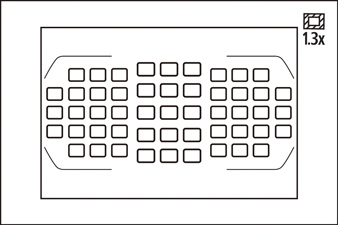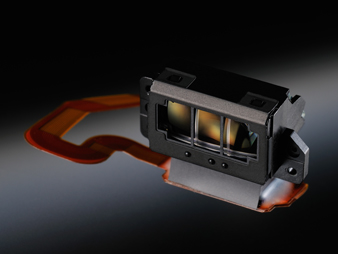The D7100 represents several firsts for Nikon. Nikon developed a new autofocus module incorporating technology found the flagship D4, e. A new viewfinder information display was developed using organic light-emitting diodes, while a new 1.3X drop mode provides the D7100 new capabilities in telephoto photography.
 1.3X crop of DX mode
1.3X crop of DX mode
This is a an additional 1.3X crop of the normal 1.5X DX drop, making an equivalent of approximately 2X crop compared with a full-frame 35mm camera. This effectively doubles the focal length of full frame lenses. Shooting with the 1.3X crop also improves maximum frame rate to 7fps from 6fps. The 1.3X crop of DX creates images that are 15.4 megapixels (4,800 x 3,200 pixels). As an added benefit, the 51 auto focus points are spread across the entire frame width and height when shooting in 1.3X crop. The 1.3X crop mode can also be applied when shooting video, which allows full HD resolution 1920 x 1080 to be recorded at 60i/50i.

Advanced Multi-CAM 3500DX autofocus sensor module
The 51-point autofocus sensor is based on the one found in the D4. It can detect down to -2EV which is similar to subjects illuminated by moonlight. Fifteen of the sensors are cross type. All points are sensitive to f/5.6 and the center point is sensitive at f/8. This means you can use a 2X teleconverter with a f/4.0 lens and still achieve autofocus functionality. This is the first time a camera with f/8 sensitivity has been offered in DX format. Combined with the 1.3X crop of DX mode making a 2X equivalent focal length multiplier (in 35mm terms) the D7100 will open up new possibilities for super-long telephoto shooting.
 OLED viewfinder information display
OLED viewfinder information display
Nikon has developed a new organic EL display for the D7100. The display found at the bottom of the viewfinder shows shooting information including exposure, aperture, shutter speed and frames remaining. By using organic light-emitting diodes instead of the traditional LCD display results in brighter and sharper details, responds faster at low temperatures and maintains its visibility when shooting bright subjects. OLED displays consume about 40% of the power as LCD displays.
